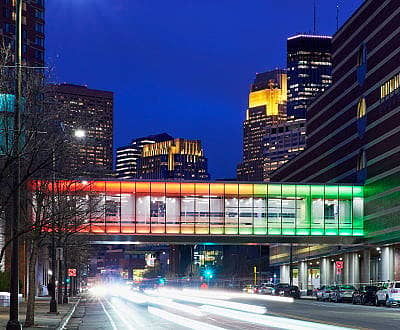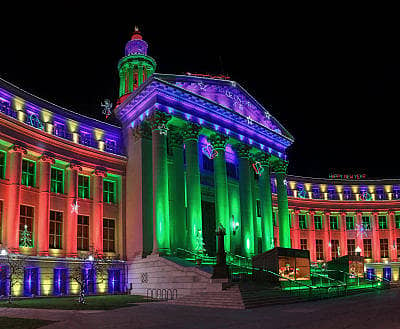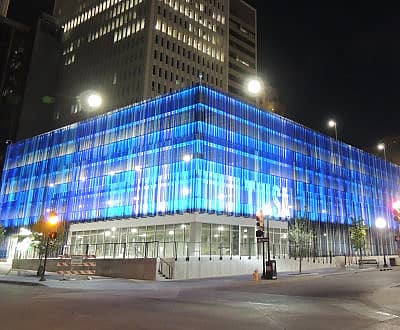Let’s set the stage: you or your customer have decided that you want your building illuminated with dynamic lighting content. You want different colors displayed on the exterior, and you’re willing to pay for the bells and whistles. You purchase the products, the contractor completes the install, and someone comes to the facility to program the lighting to do exactly what you want. But what exactly is it that you want?
Dynamic lighting manufacturers and/or programmers will generally ask the customer for a list of content they need for programing. Sometimes people will go online searching for a list of effects that could help them decide what to put on their content list. Providing a list to serve as a guide can be a daunting task for manufacturers, especially when considering the breadth of product they have, as well as variations of the product. There are numerous factors that impact lighting displays and the effects they have, including:
- Direct View vs. Indirect View
- Linear vs. Non-Linear
- Graze vs. Wash vs. Media vs. Backlighting
- Static vs. Dynamic (Tunable) White vs. RGB vs. RGBW vs. RGBA vs. RGBL vs. RGBAW
Even the surface(s) being illuminated has an impact on lighting and this can result in an almost endless list of possibilities to provide as a guide.



The decision maker must be aware of how the lighting they purchased will perform. Not all programmed content behaves the same way on different types of fixtures. Content built based on fixtures that graze or wash a surface will look different on a linear line-of-light fixture. Programmed content containing a color chase which was built based on linear line-of-light fixtures will look different on graze and wash fixtures. Sections or gaps might need to be programmed to not illuminate to prevent color mixing that would happen with graze and wash fixtures – an issue that would not happen with linear line-of-light fixtures.
The surface(s) and finish(s) of the structure are an important consideration when planning the content of your new lighting. Red hues can look great on a dark brick surface, while Green and Blue hues may not provide the look you were hoping. Red and Green hues on a blue surface would not look great, while Blue hues on the blue surface would bring the surface to life. A textured or matte surface will pick up more light, while a highly reflective surface will dissipate that light.
Backlighting must also be reviewed in an entirely different point of view. How much light will be seen? Trying to outline objects/lettering, or will the lighting serve as a media/video piece that is behind a diffused surface? How large/small is the media/video piece? With this, the point-of-view and resolution come into consideration to best determine the type of media/video that can be shown, and the amount of diffusion and gap between the diffusion and fixtures that must be considered.
When considering content, please do not feel compelled to be specific or limited. There will be a time in which testing will be conducted. Creating a list of content could be as simple as jotting down a few ideas. More often than not, insight into what content a decision maker chooses comes from the testing period. For instance, the programmer might receive a list of content in which one of the selections is a Patriotic (Red/White/Blue) display. The programmer could create a Red, White & Blue fade for all the lights to fade through the three colors. Another option could involve a Red, White & Blue fade in which a select number of fixtures are Red, another select number of fixtures are White, and the remaining fixtures Blue. All would fade (cycle) through the colors in their own order (IE: RWB, WBR, BRW). Another option could involve an RWB chase in which the Red/White/Blue colors chase the length of the install in a certain direction. The speed of the fade or chase could be manipulated to the decision maker’s advisement and from the testing, the decision maker can now add more to their list.
An easy list to consider could include the below, and with this list, the programmer can show the capabilities of the controls and fixtures, thus inspiring a more finite direction and possibly new ideas.
| Holidays | Special Awareness | Sports | Corporate Colors |
|---|---|---|---|
| Christmas | Breast Cancer Month | Professional Team Colors | Branding Color Standards |
| Halloween | Colon Cancer Month | University Team Colors | |
| St. Patrick’s Day | Autism Awareness Month | ||
| Valentines Day |
In closing, dynamic lighting isn’t limited to color changing. Great shows can be done with Static and Dynamic (tunable) White fixtures. Static fixtures can be programmed to pulse or dim/brighten to create a dynamic effect. An install could include motion sensors that detect the movement of a person or people walking along a sidewalk while the lights move along the same path. Dynamic (tunable) White fixtures could be programmed to transition to different Kelvin temperatures based on the seasonal changes throughout the year. The creativity is in the mind and imagination of the decision maker and/or programmer.

